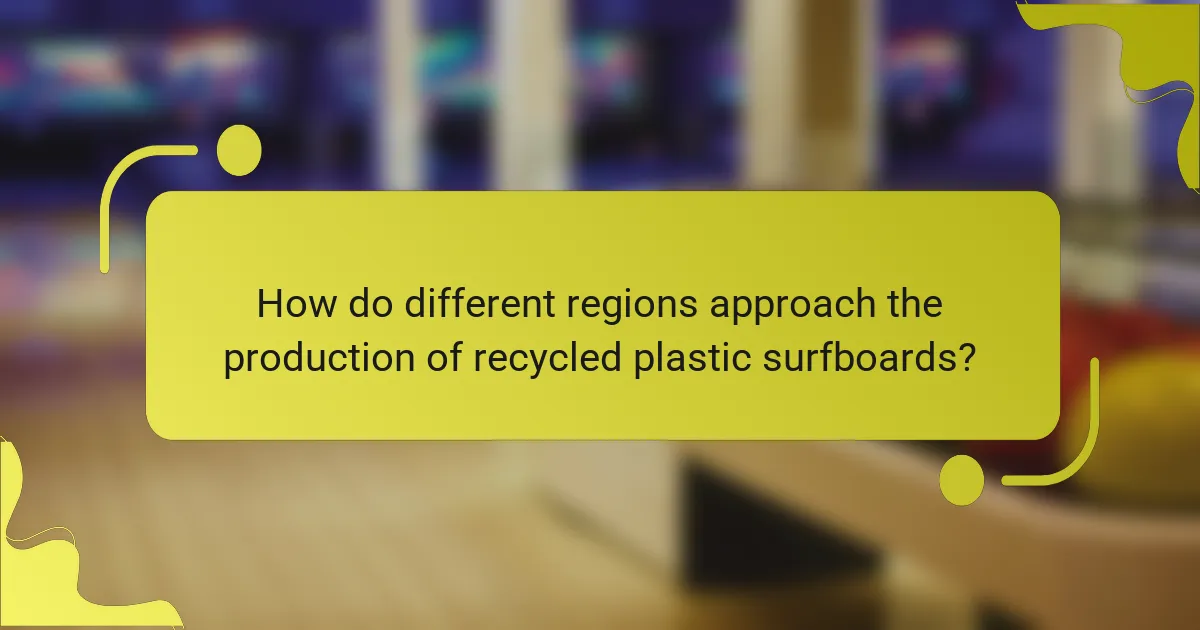Recycled plastic surfboards significantly reduce waste and conserve resources, promoting sustainability in the surfing industry. They feature innovative designs that enhance performance while minimizing environmental impact. Various regions adopt unique approaches to production, emphasizing local sourcing and advanced technology. Surfers can support eco-friendly practices by choosing these sustainable alternatives and engaging in community initiatives.

What are the environmental benefits of recycled plastic surfboards?
Recycled plastic surfboards provide significant environmental benefits by reducing waste and conserving resources. They help divert plastic waste from landfills and oceans, promoting a circular economy. Additionally, these surfboards often require less energy to produce compared to traditional materials, lowering carbon emissions. Their durability also extends the lifespan of the product, further minimizing environmental impact. As a result, adopting recycled plastic surfboards contributes to sustainability in the surfing industry.
How do recycled materials reduce ocean pollution?
Recycled materials, such as plastic surfboards, significantly reduce ocean pollution by preventing waste from entering marine environments. These surfboards utilize post-consumer plastic, which decreases reliance on virgin materials and lowers carbon emissions. Innovations in design ensure durability and performance, making them viable alternatives to traditional surfboards. As a result, using recycled plastics not only contributes to cleaner oceans but also promotes sustainable practices within the surfing community.
What impact do recycled surfboards have on carbon footprint?
Recycled surfboards significantly reduce carbon footprints by minimizing waste and lowering the need for new materials. These boards often use post-consumer plastic, which decreases greenhouse gas emissions associated with production. For example, a study found that using recycled materials can cut emissions by up to 30%. Additionally, innovations in design enhance performance while promoting sustainability, making recycled surfboards a valuable choice for eco-conscious surfers.
How does using recycled plastics contribute to sustainable surfing?
Using recycled plastics in surfboards significantly reduces environmental impact and promotes sustainability. Recycled plastic surfboards minimize waste, decrease reliance on virgin materials, and lower carbon emissions during production. Innovations in design enhance performance while maintaining durability. For example, companies are now utilizing advanced composite materials that incorporate recycled plastics, improving both the ecological footprint and the surfing experience. This approach not only supports ocean health but also aligns with the growing demand for eco-friendly products among consumers.

What design innovations are transforming recycled plastic surfboards?
Recycled plastic surfboards are being transformed by innovative designs that enhance performance and sustainability. These surfboards utilize advanced materials that improve durability while reducing environmental impact. Innovations include incorporating bio-based resins and optimizing shapes for better hydrodynamics. As a result, they offer a unique blend of eco-friendliness and high performance, appealing to environmentally conscious surfers.
Which technologies enhance performance in recycled surfboards?
Recycled plastic surfboards benefit from technologies like bio-resins, advanced shaping techniques, and sustainable manufacturing processes. These innovations enhance performance by improving durability, flexibility, and environmental impact. For example, bio-resins reduce reliance on fossil fuels and often result in lighter boards. Advanced shaping techniques allow for better hydrodynamics, enhancing speed and maneuverability. Sustainable manufacturing processes minimize waste and energy consumption, contributing to overall sustainability in surfboard production.
How are manufacturers integrating eco-friendly designs?
Manufacturers are integrating eco-friendly designs by using recycled plastics in surfboards, reducing waste and carbon footprint. These surfboards offer durability and performance while promoting sustainability. Innovations include advanced manufacturing techniques that enhance the material’s strength and flexibility. Additionally, brands are emphasizing lifecycle assessments to ensure minimal environmental impact from production to disposal.
What role do aesthetics play in the appeal of recycled surfboards?
Aesthetics significantly enhance the appeal of recycled surfboards by combining environmental consciousness with innovative design. The unique visual qualities of these surfboards often attract eco-minded surfers. Their vibrant colors and textures, derived from recycled materials, create distinct styles that stand out in the market. As a result, aesthetics play a crucial role in promoting sustainable surfing practices while appealing to a broader audience.

How do different regions approach the production of recycled plastic surfboards?
Different regions adopt varied approaches to producing recycled plastic surfboards, emphasizing sustainability and innovation. For instance, California focuses on integrating advanced technology to enhance durability and performance. In contrast, Australia prioritizes local sourcing of recycled materials, promoting community engagement. European manufacturers often emphasize eco-certifications, ensuring environmentally friendly practices throughout production. This regional diversity highlights unique attributes in design and material usage, contributing to the overall environmental benefits of recycled plastic surfboards.
What are the leading brands in North America focusing on sustainability?
Leading brands in North America focusing on sustainability in recycled plastic surfboards include Firewire Surfboards, Sustainable Surf, and Catch Surf. These companies prioritize environmental benefits through innovative design and materials. Firewire uses eco-friendly resins and recycled materials, while Sustainable Surf emphasizes carbon-neutral production. Catch Surf incorporates post-consumer plastic, showcasing a commitment to reducing ocean waste. These brands exemplify the shift towards sustainable practices in the surf industry.
How does the European market prioritize eco-friendly surfboard designs?
The European market prioritizes eco-friendly surfboard designs by focusing on sustainable materials and innovative manufacturing processes. Recycled plastic surfboards significantly reduce waste and carbon footprints. Brands are implementing design innovations that enhance performance while maintaining environmental integrity. For example, some surfboards use up to 50% recycled materials, showcasing the industry’s commitment to sustainability. This trend reflects a growing consumer demand for environmentally responsible products in the surfing community.
Which local initiatives support recycled surfboard production?
Local initiatives supporting recycled surfboard production include community workshops, environmental organizations, and surf shops focused on sustainability. These programs often collaborate to promote eco-friendly materials and educate surfers about the benefits of using recycled products. For instance, some workshops provide hands-on experiences for creating surfboards from reclaimed plastics, fostering innovation in design while reducing waste. Additionally, local surf competitions may feature categories for eco-friendly boards, encouraging manufacturers to adopt sustainable practices.

What are the unique attributes of specific recycled plastic surfboards?
Recycled plastic surfboards have unique attributes that enhance their sustainability and performance. They incorporate innovative materials, such as high-density polyethylene, which provide durability while reducing environmental impact. These surfboards often feature customizable designs, allowing for personal expression. Additionally, they can be produced with lower energy consumption compared to traditional materials, contributing to a smaller carbon footprint. Some models include features like lightweight construction and improved buoyancy, which enhance maneuverability in water.
How do custom designs cater to niche markets?
Custom designs for recycled plastic surfboards effectively cater to niche markets by emphasizing sustainability and innovation. These surfboards appeal to environmentally conscious consumers who prioritize eco-friendly products. The unique attribute of utilizing recycled materials not only reduces waste but also enhances the board’s performance. Additionally, design innovations such as customizable shapes and sizes allow for personalization, attracting diverse surfers with specific preferences. This alignment between environmental benefits and tailored designs fosters a strong connection with niche market segments.
What features differentiate premium recycled surfboards from standard models?
Premium recycled surfboards feature advanced materials and design innovations that enhance performance and sustainability compared to standard models.
They often utilize higher quality recycled plastics that provide better durability and flexibility. Unique attributes include eco-friendly epoxy resins and customizable designs that cater to specific surfing styles. Additionally, premium models may incorporate lightweight construction techniques that improve maneuverability. Rare features might include limited edition designs that showcase artistic collaborations with environmental artists.

What challenges do manufacturers face in the recycled surfboard industry?
Manufacturers in the recycled surfboard industry face several significant challenges. High production costs and limited access to quality recycled materials hinder scalability. Additionally, achieving consistent performance and durability in recycled surfboards remains a technical hurdle. Consumer perception and demand for these products also pose obstacles, as many still favor traditional surfboards. Finally, navigating regulatory compliance for environmental standards adds complexity to manufacturing processes.
How do supply chain issues affect the availability of recycled materials?
Supply chain issues significantly reduce the availability of recycled materials for surfboard production. Disruptions in logistics and transportation can delay the collection and processing of plastic waste. This scarcity impacts the production timelines and costs of recycled plastic surfboards. As demand for sustainable products grows, consistent access to recycled materials becomes critical for manufacturers aiming to innovate environmentally friendly designs.
What are the common misconceptions about recycled plastic surfboards?
Many misconceptions exist about recycled plastic surfboards, primarily regarding their performance and environmental impact. Some believe these boards are less durable than traditional materials, but advancements in design and technology have improved their strength significantly. Another common myth is that recycled surfboards perform poorly in water; however, many surfers report comparable, if not superior, performance. Additionally, some assume that using recycled materials compromises aesthetics, yet innovative designs often enhance visual appeal. Lastly, there is a misconception that recycled plastic surfboards are not eco-friendly; in reality, they help reduce plastic waste and promote sustainability in the surfing industry.

What best practices can surfers adopt to support sustainable surfing?
Surfers can support sustainable surfing by choosing recycled plastic surfboards, which minimize environmental impact and promote eco-friendly practices. These surfboards reduce plastic waste and often utilize innovative designs that enhance performance. For instance, some models incorporate bio-resins, improving durability while remaining environmentally conscious. Additionally, surfers can engage in local clean-up efforts, promoting ocean health and supporting brands committed to sustainability. By making informed choices, surfers can significantly contribute to a healthier planet.
How can surfers choose the right recycled surfboard for their needs?
Surfers can choose the right recycled surfboard by considering their surfing style, board dimensions, and material quality. Assessing the environmental benefits of recycled materials, such as reduced plastic waste and lower carbon footprints, is crucial. Innovations in design, like improved durability and performance characteristics, also play a significant role in selection. Additionally, consulting reviews or expert recommendations can guide surfers in making informed decisions tailored to their needs.
What maintenance tips extend the life of recycled plastic surfboards?
Regular maintenance can significantly extend the life of recycled plastic surfboards. Clean the board after each use to remove salt and sand, which can degrade materials over time. Store the surfboard in a cool, dry place away from direct sunlight to prevent warping. Inspect for cracks or damage regularly; repair small issues promptly to prevent further deterioration. Use a protective wax or coating to enhance durability and maintain surface integrity.
Which organizations promote sustainable surfing practices?
Organizations promoting sustainable surfing practices include Surfrider Foundation, Sustainable Surf, and 1% for the Planet. These groups advocate for eco-friendly surfboard production, beach cleanups, and ocean conservation. Surfrider Foundation focuses on policy change and community engagement, while Sustainable Surf champions the use of recycled materials in surfboards. 1% for the Planet encourages businesses to donate a percentage of sales to environmental causes, supporting sustainable surfing initiatives.




